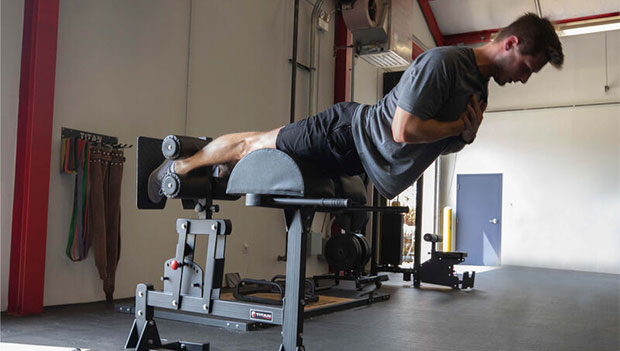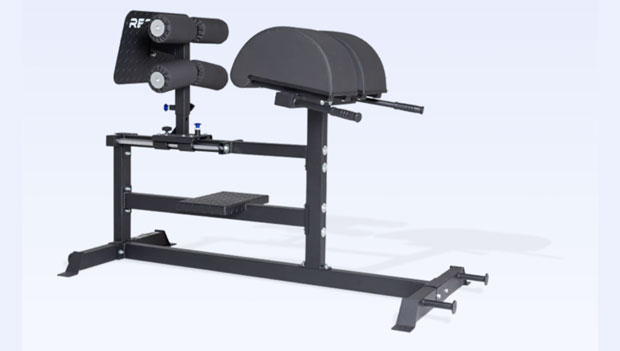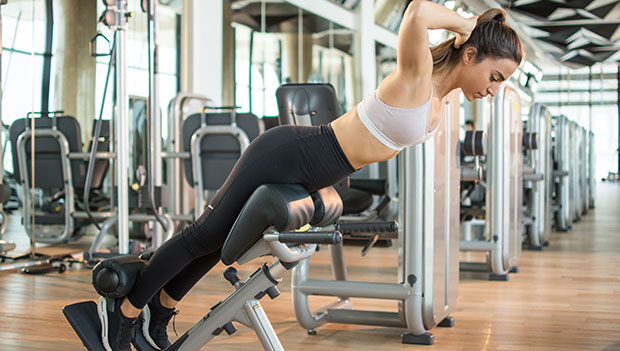
By clicking on the product links in this article, we may receive a commission fee at no cost to you, the reader. Sponsorships and affiliate commissions help support our research so we can help you find the best products. Read our full affiliate disclosure here.
The older I get, the more my body lets me know that my training has some holes. After a day of trying to keep up with my kid or doing a yard or house project I’ve been putting off for a while, I find aches and pains where I didn’t have them before. My posterior chain—the muscles that go down your back along the spine and legs—is an area of particular concern.
If you get similar pain, the likely culprit is an under-trained lower back, glutes, or hamstrings. To correct this, you can perform glute workouts at home, on glute machines, or even on a weight bench. There are also plenty of full back workouts that target the upper part of your posterior chain.
Two excellent exercises ideal for posterior chain work are: glute ham raises or back extensions. But which is better? In this article, we’ll look at glute ham raises vs. back extensions, what they are, how you do them with good form, and the benefits of each exercise.
Why Trust Us?
The health and safety of ACTIVE's readers is of the utmost importance to us. To ensure your well-being when consuming protein powders, the ACTIVE.com editorial team prioritizes products that are independently tested by a third-party. We've also consulted with a team of nutritionists and dieticians to ensure the products we feature are of the highest standard. This helps us create the most accurate, authentic review content for our readers. More importantly, fitness may be our job, but it is also our passion. Therefore, we strive to bring you products that we trust and would personally use.
What Is a Glute Ham Raise?
As the name implies, glute ham raises target your hamstrings and glutes simultaneously, but if you’re doing them correctly, you should feel the burn in your hamstrings the most. This exercise is very effective, not just because it isolates these two major muscles but because it also trains them in their full range of motion.
Your glutes and hamstrings are activated when you bend your knees and extend your hips. Traditional exercises come up short because they only use one of those motions at a time. For example, if you regularly lift weights, you probably have squats in your routine.
Squats work the glutes and hamstrings through the bended knee range of motion but don’t extend the hips. On the other hand, lifts like kettlebell swings activate them through hip extension but not knee flexion.

Benefits of Glute Ham Raises
- Can help build leg strength
- Helps improve other exercises like squats and deadlifts
- Athletic moves like sprinting and jumping can become easier
- Helps with injury prevention
- Helps posture
How to Do A Glute Ham Raise
The Set-up:
Glute ham raises are considered an auxiliary exercise because you don’t typically use weights during the movement. But that can be misleading because they’re not a simple movement, and if you don’t use the proper equipment, you could risk injury.
To get properly set up for this exercise, you’ll need a piece of equipment called a glute ham developer or GHD. GHDs are angled benches that allow you to secure your feet and rest your weight on a pad that sits on the lower part of your hips. The pad placement is key because it shifts your body weight from your core to your glutes and hamstrings.
The Movement:
- On the machine, make sure your feet are secure and the pad is under your hips.
- Tighten your core and glutes, then lower your weight forward until your body is parallel to the floor.
- Keep your core and glutes tight, then raise your body back to the upright position. Repeat for desired reps.
Tips:
- Don’t start out going all the way parallel to the floor. If you have a muscular imbalance in your hips, glutes, or hamstrings from sitting all day, previous injury, or undertraining, work your way up to full extension.
- Try your best not to bend at your waist. It is likely that your core is used to taking the load off your hamstrings and glutes, but that is what leads to muscular imbalances and injury.
- Position the pads properly. If your pads are under the lower part of your hips then the hamstrings and glutes will bear the load. If you move them up your lower back will take the load, and if you move them down your knees will.
- Keep your back straight as you raise up. Similar to bending at the waist, your back will likely try to hyperextend to take some of the load from your hamstrings and glutes. Make sure you stay in a straight line.
What Is a Back Extension?
Back extensions look similar to glute ham raises and are done on similar equipment. Where the glute ham raise focuses on developing your glutes and hamstrings, the back extension focuses on developing the muscles in your lower back that support your spine.
Your lower back muscles are part of your core. You probably already knew that, but if you don’t train them in isolation, very few core exercises recruit your lower back alongside your abs and obliques to help develop them. This lack of development can lead to muscle imbalances that can cause pain and injury.

Benefits of Back Extension
- Helps strengthen your entire core
- Helps improve posture
- Lowers risk of back injury
- Contributes to improvements in overall strength
How to Do A Back Extension
The Set-up:
Proper form on back extensions means your body is straight and can bend at the waist. You can do this exercise with different equipment—and you can find ways to do it without any equipment online—but if you’re just getting started, I highly recommend you use an angled bench when possible.
The form guide below operates under the assumption that you're using a 45-degree angle bench.
The Movement:
- Lay face down on the bench. The pads should be resting right on the upper part of your hips.
- Cross your arms across your chest, tighten your core, squeeze your glutes, and hinge at the waist. This means you should be lowering your upper body towards the floor.
- Keep your core tight and raise your upper body back to the starting position. Repeat for desired reps.
Tips:
- One of the biggest mistakes I’ve seen people make with back extensions is arching their back. Usually this happens because you’ve overextended, and the front part of your core is trying to take over. Keep your back as straight as possible, and if necessary, work your way up to full extension.
- The movement should be slow and controlled at all times. If you are working too fast it is hard to make sure you are using the correct muscles to lift yourself. This can lead to injury.
Equipment You May Need
Let’s talk about equipment. I’ve referenced several pieces of equipment in this article, but do you need them to perform these exercises?
I say yes. If you’re going to build your lower back muscles, you have to do it right. And when it comes to strengthening key muscles that support your spine, posture, and everyday movement, using specific equipment is much safer than alternatives.
But that doesn’t mean you don’t have options. Let’s briefly dive into some specific equipment and what you could use it for, plus some alternatives if you’re on a budget.
Glute Ham Developer (GHD)
If you are searching online for glute ham raises, you’ll definitely come across GHDs. This equipment is also called a glute ham machine, glute extension machine, and a couple of other names, but glute ham developer is its proper name.
GHDs come in different shapes and sizes depending on the brand. What you’re looking for here is a wide base, strong foot security made up of a metal platform and rollers, and adjustable pads for positioning.
These are all high-quality GHDs that I would recommend without hesitation, but they’re also great reference points to visualize what you should be looking for.
- REP Fitness Glute Ham Developer
- Titan Glute and Hamstring Developer
- Rogue Echo GHD
- Rogue Floor Glute
Hyperextension Bench
You’ve probably seen hyperextension benches around if you’ve ever had a membership to a commercial gym. They’re usually near the dumbbells because people use them to angle their body and increase the difficulty of movements like rows or flyes.
Like GHDs, hyperextension benches need a strong metal platform for your feet and, ideally, adjustable pads to make sure you’re keeping the load on the correct muscles. The best angle for back extensions is 45 degrees, and most hyperextension benches are fixed at that angle.
Here are a few products to check out if you’re interested in adding a hyperextension bench to your home gym:
- Sunny Health 45-Degree Hyperextension
- Rogue Pro Oblique Flexor
- Titan Hyper/Roman Chair V2
- Titan Seated Ab/Back Extension Machine
Alternative Equipment
If you’re comparing back extensions and glute ham raises, one consideration is the alternative equipment. With glute ham raises you are relatively limited to either a GHD or a weight bench that has the right attachment.
Back extensions can be done with a good exercise ball, or on the floor to some extent, so you have options. But I highly recommend getting the proper equipment or joining a gym that already has the necessary equipment. It is better for your safety, and it is better for your gains.
Glute Ham Raise vs. Back Extension: Which is Better?
Glute ham raises and back extensions are similar exercises in that they both work an often neglected part of your posterior chain. The lower back, glutes, and hamstrings are all extremely important parts of your body’s strength.
But if pressed, I would have to say back extensions are the better exercise because they are easier to perform and can be done safely with limited equipment, where your risk of injury is higher with glute ham raises.
FAQs
Do back extensions grow glutes?
Yes, when done properly back extensions will recruit your glutes and help make them stronger.
Are glute ham raises effective?
Yes, glute ham raises are very effective at isolating and strengthening your glutes and hamstrings.
Do back extensions actually work?
Yes, back extensions are one of, if not the best, exercise to strengthen your lower back and glutes.
Can glute ham raises replace deadlifts?
Glute ham raises can replace deadlifts as a low-impact alternative but are an isolation movement, so you’ll want to incorporate other exercises to replace the full benefit of performing deadlifts.


